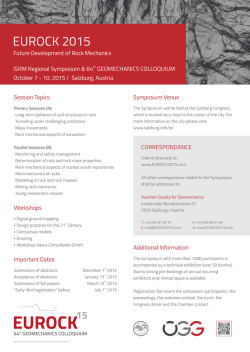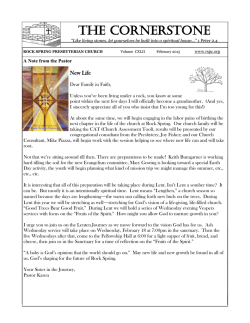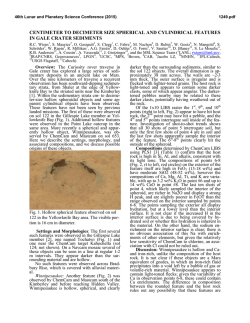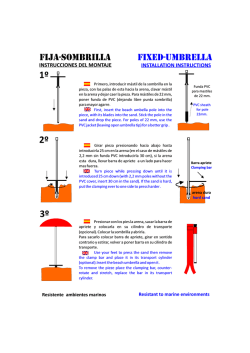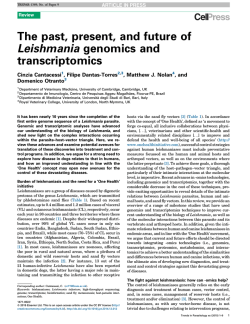
rock abrasion and landscape modification by windblown sand as
46th Lunar and Planetary Science Conference (2015) 2324.pdf ROCK ABRASION AND LANDSCAPE MODIFICATION BY WINDBLOWN SAND AS DOCUMENTED BY THE MSL CURIOSITY ROVER N.T. Bridges1, D.L. Blaney2, M.D. Day3, K.E. Herkenhoff4, N.L. Lanza5, S. Le Mouélic6, F.J. Martin-Torres7, S. Maurice8, C.E. Newman9, H.E. Newsom10, R.C. Wiens5, M-P. Zorzano11, and the MSL Science Team ; 1Applied Physics Laboratory, 11100 Johns Hopkins Road, Laurel, MD 20723 ([email protected]); 2Jet Propulsion Laboratory, California Institute of Technology, Pasadena, CA 91109; 3Department of Geological Sciences, Jackson School of Geosciences, University of Texas at Austin, Austin, Texas 78705; 4U.S. Geological Survey, Flagstaff, AZ 86001; 5Los Alamos National Laboratory, Los Alamos, NM 87545; 6CNRS/Université de Nantes, 44322 Nantes cedex 3, France; 7Instituto Andaluz de Ciencias de la Tierra (CSICUGR), Granada, Spain; ; 8IRAP, CNRS-Université Toulouse, 14 av. E. Belin, 31400 Toulouse, France; 9Ashima Research, Pasadena, CA 91106; 10Department of Earth and Planetary Sciences, University of New Mexico, Albuquerque, NM 87131-0001; 11 Centro de Astrobiología (INTA-CSIC), Madrid, Spain Introduction Mars is a dry planet, with actively blowing sand in many regions [1-5]. In the absence of stable liquid water and an active hydrosphere, rates of chemical weathering are slow, such that aeolian abrasion is a dominant agent of landscape modification where sand is present and winds above threshold occur at sufficient frequency. Reflecting this activity, ventifacts, rocks that have been abraded by windborne particles, are common on the Martian surface. They provide invaluable markers of the Martian wind record and insight into climate and landscape modification. Yardangs are also indicative of sand abrasion, but, given their size of several meters to kilometers, reflect larger scale wind patterns. The Mars Science Laboratory (MSL) Curiosity payload is well suited for studying ventifacts and modern wind patterns which are relevant for understanding current and past abrasion/wind conditions [6]. The rover mast cameras, Navcam, Mastcam, and the ChemCam Remote Micro Imager (RMI) provide images of varying coverage and spatial scale. In particular, the Mastcam M100 (right eye) and ChemCam Remote Micro Imager (RMI), with pixel scales 74 [7] and 19.6 µrad [8-9], provide fine details of rock textures. The ChemCam Laser Induced Breakdown Spectrometer (LIBS) gives elemental composition as a function of depth down to ~10s of µm beneath rock surfaces, penetrating the outer dust layer and providing clues to the presence of any rock coating or rind [11,12]. The Rover Environmental Monitoring Station measures wind speed and direction, pressure, relative humidity, air temperature, ground temperature, and ultraviolet radiation, with 1 Hz sampling for over 5 min every hour and periodic (generally daily) observations for durations of an hour or more [13]. Finally, the HiRISE camera on the Mars Reconnaissance Orbiter provides 25 cm pixel-scale images which are used to compare MSL results to regional scale geology and topography, including the presence and inferred formative wind directions of dunes and yardangs. Here we provide the latest measurements and interpretations of the rock abrasion record in Gale Crater, adding to the data that was previously analyzed through Sol 100 [6]. Methods Ventifacts through Sol 438 were identified in systematic searches through all M100 mosaics and associated RMI and MAHLI images, the three datasets with the highest spatial resolution (similar methods to [6]). Diagnostic characteristics were tabulated for each ventifact, including 1) overall shape (facet, keel, basal sill), 2) macro-texture (elongated pits, scallops, flutes, grooves, and rock tails) and 3) micro-texture (lineations). Once found, rocks were located in the lower resolution Navcam data, such that the location, size (height and width), and orientation of most ventifacts could be computed using Navcam stereo mosaics in the Mars Science Laboratory InterfaCE (MSLICE) software package available to the MSL Team. Several Mastcam orthoproducts were also made to more accurately map ventifact features. The presence of rock coatings/rinds was assessed by looking at the vertical distribution of mobile elements such as lithium in LIBS data [12] and then comparing to the rock texture (e.g., abraded vs. unabraded). The ventifact locations were projected onto the color portion of an orthorectified High Resolution Imaging Science Experiment (HiRISE) image with and overlain rover traverse path and sol location markers. The orientations were also compiled into rose diagrams and, following past convention, shown as a function of upwind direction. These were compared to directions of local yardangs [14], migration direction and orientations of dunes in the Bagnold dunefield to the southwest [15], and winds predicted by the MarsWRF atmospheric model [6]. Finally, general geomorphic observations, such as valley widening and distribution of boulders, was noted qualitatively using Mastcam mosaics. Results Ventifacts are found throughout the traverse and contain one or more diagnostic features and textures: Facets, keels, basal sills, elongated pits, scallops/flutes, grooves, rock tails, and lineations (Fig. 1). Keels at the junction of facets are sharp enough to pose a hazard MSL’s wheels in some areas. Other rocks show basal undercuts indicative of enhanced scour in the zone of highest abrasion. Geomorphic and textural patterns on outcrops indicate retreat of windward faces. For example, Moonlight Valley and other depressions are demarcated by undercut walls and scree boulders, with 46th Lunar and Planetary Science Conference (2015) the valley interiors containing fewer rocks, most of which show evidence for significant abrasion. Together, this suggests widening and undercutting of the valley walls, and erosion of interior rocks, by windblown sand. The rose diagram of ventifact-derived wind azimuths shows inferred winds shows a strong bias to westerly flow (38 measurements, or 79% percent of sample), with the strongest trend in the 210-240° bin (Fig. 2) [6]. In contrast, the direction of scarp retreat and rock tails in the Sheepbed mudstone to the northeast of Rocknest indicates northeasterly winds that, based on cosmic ray exposure ages, occurred 78±30 Ma [15]. Both datasets disagree with the direction of strongest winds from MarsWRF predictions of the strongest winds coming from the SSE and the NNW-SSE orientation of Gale Crater yardangs. Finally, dune and ripple orientations and displacement in the Bagnold dunefield to the southwest indicate strong bidirectional winds from the NW and ENE [16]. The disparity in these datasets may reflect the effects of local topography and a preserved record of rare sand mobilizing events that are best seen at the field (ventifact scale), whereas yardangs and bulk dune motion are more reflective of longer term mesoscale winds. As a preliminary investigation of the potential for using LIBS to assess abrasion of any rock coatings/rinds, the 670.9 nm lithium line (corresponding to an unresolved doublet at 670.96/670.98 nm [12]) for 5 LIBS observation points each on Bathurst Inlet and Jake M. rocks were compared [6]. They show clear differences as a function of depth for shots 4–30, beneath the dust cover. Whereas line intensity in Bathurst, particularly raster points 3–5, decreases with depth, all five of the Jake points remain more or less constant, even point 1 that exhibits higher overall Li. The LIBS points on Jake are located on a rough surface with elongated pits that are characterized by abrasion subparallel to the surface. The LIBS points on Bathurst Inlet are on a smooth surface that qualitatively appears less abraded. Discussion Ventifacts and other evidence for rock abrasion are found throughout the rover drive, yet HiRISE images do not show any dark sand dunes in the traverse so far, in contrast to the large dune field to the south that is migrating up to 2 m per year. This indicates that rock abrasion was likely more dominant in the past, a hypothesis consistent with rapid scarp retreat in Yellowknife Bay [16]. Ventifacts and evidence for bedrock abrasion have also been found at the Pathfinder, Spirit, and Opportunity sites, areas, like the Curiosity traverse so far, that lack evidence for current high sand fluxes. Yardangs are also common on the planet, regardless of whether local sand is mobile. This suggest that abrasion on Mars is an episodic process driven by the passage of sand in which rock retreat rates, based on fluxes of current active dunes, may reach 10s of microns per year [5]. Such a process has acted, over long time 2324.pdf scales, to imprint upon the surface a record of sand activity. Fig. 1: a): Jake rock. At left is a color Mastcam 34 image (ML_401573007EDR_S0042100AUT_04096M) with superposed RMI mosaics shown in grayscale and the location of LIBS spots as red dots (lithium peaks at 670.9 nm from the right- most raster described in text); b) Slide Mountain rock (mcam01715, Sol 417) showing prominent undercutting, presumably from southwesterly winds, c) Classic faceted ventifact (mcam01675, Sol 404). Fig. 2: Upwind directions based on several datasets and models. References [1] Silvestro, S. et al. (2010), GRL, 37, doi:10.1029/2010GL044743. [2] Chojnacki et al. (2011), JGR, 116, doi:10.1029/2010JE003675. [3] Hansen, C.J. et al. (2012), Science, 331, 575-578. [4] Bridges et al. (2012a), Geology, 40, 31-34. [5] Bridges et al. (2012b), Nature, 485, 339-342. [6] Bridges et al. (2014), JGR-Planets, 119, 13741389. [7] Malin, M.C. et al. (2010), Lun. Planet. Sci. XLI, 1123. [8] Maurice, S. et al. (2012), Space Sci. Rev., doi: 10.1007/s11214-012-9912-2. [9] Le Mouélic, S. et al. (2014), Icarus, doi10.1016/j.icarus.2014.05.030 [10] Wiens, R.C. et al. (2012), Space Sci. Rev., doi: 10.1007/s11214-0129902-4. [11] Lanza, N.L. et al. (2014), GRL, 41, 5755-5763, doi:10.1002/2014GL060329. [12] Ollila, A.M. et al. (2014), JGR -Planets, 119, 255-282, doi:10.1002/2013JE004517. [13] Gomez-Elvira, J., et al. (2011), 4th International Workshop on the Mars atmosphere. [14] Day, M.D. et al. (2014), GSA Annual Meeting, 202-13. [15] Silvestro, S. et al. (2012), Geology, 41, 483-486. [16] Farley, K.A. et al. (2014), Science, 343,1247166.
© Copyright 2025
